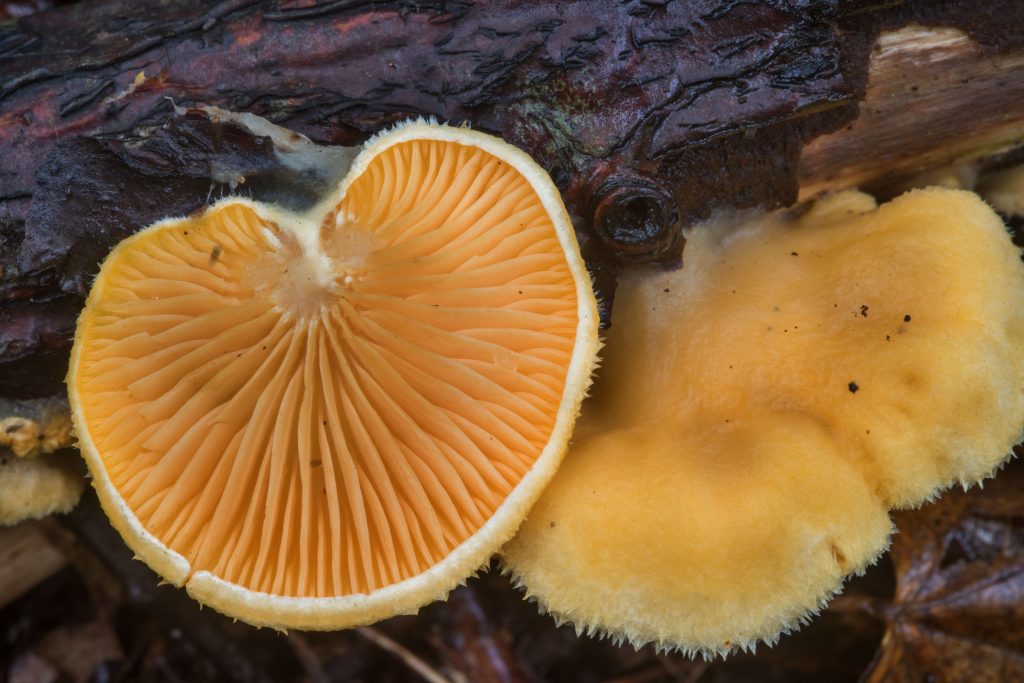Phyllotopsis nidulans, commonly known as the Mock Oyster or Orange Oyster Mushroom, is a fascinating species of shelving mushroom characterized by its distinctive fan-shaped pale orange cap covered in peach fuzz and a foul, disagreeable odor.[i],
The taxonomic history and classification of this species is not very reliable. First described by the German mycologist Christiaan Hendrik Persoon in 1798 as “Agaricus nidulans”, this species has moved genus several times. It has been a part of the Pluteaceae (hence the “mock oyster”) and the Omphalotaceae families as well as a part of the wastebasket taxon of Tricholomataceae. As such readers may come across this species under the “synonymous” names of Panellus nidulans and Claudopus nidulans.
However, according to modern DNA studies, none of these taxons have accurately categorized this species. As such, as new genetic and morphological data become available the classification of this species is expected to be revised.
From an etymological perspective, the epithet “nidulans” means encased or lying in a nest or cavity (“Nid-“ is Latin for nest). It is from here that one of its common names, the nestcap, takes root. Although why this species is associated with nesting or cavities is not very clear.
Identification and Description[ii],[iii],[iv]
Cap: The cap of Phyllotopsis nidulans measures 2 to 8 centimeters in diameter at maturity. The cap of younger specimens is mostly convex, as specimens mature their caps elongate and become nearly flat with a fan-shaped or scalloped outline. The margins of the cap are inrolled both in young and older specimens. The surface of the cap is dry and is covered in coarse to soft fuzz-like short white hairs. The color of the cap is a very distinctive orange-yellow which fades to a paler buff color with age.
Flesh: The flesh of this species is thin and somewhat pliant. In color, the flesh is buff-brown.
Gills: The gills of this mushroom are broadly attached, relatively narrow, closely spaced, and radiate outward from their point of attachment. They are orange-buff to orange-yellow and may darken slightly with age.
Stalk: The species typically lack a stalk. However, rarely when the stalk is present in specimens it is rudimentary and very short. This species also lacks a partial veil.
Spores: The spores of Phyllotopsis nidulans are elliptical in shape, with smooth surfaces. They measure approximately 4.5–6 x 1.5–3 µm. They are hyaline, meaning they are colorless and transparent. They are also inamyloid, meaning they do not produce the characteristic blue-black staining when subjected to Melzer’s reagent or Lugol’s solution. Under a microscope, the spores appear to be translucent and may have a slightly yellowish tint.
Spore Print: The spore print of Phyllotopsis nidulans is yellowish-pink to apricot-pink. In certain specimens it may be very pale, appearing white unless viewed against a pure white background.
Odor: This species has a distinctive, unpleasant, and disgusting odor that has been described as skunk-like, sewer gas-like or rotten egg-like.
Edibility: Phyllotopsis nidulans is considered inedible due to its fetid odor. Although the taste of this species is reported as “unpleasant” in several mycological sources.
Habitat: This species is saprobic and is commonly found growing in groups or shelving clusters on decaying wood, such as dead logs, stumps, and fallen branches.
Range: P. nidulans has a wide wide geographic distribution and is found in temperate forests throughout North America, Europe, and Asia. In North America, it has been reported from Canada down to Mexico but is more common from the Great Lakes eastward.
Fruiting Season: The fruiting season for this species is from late summer to early winter, depending on the climate and location.
- August in Colorado
- September-October in the Northeastern United States
- November in Texas
- Fall-winter in California
Look-A-Likes[v]
Although the orange color of the fan-shaped cap, unpleasant odor, and growth on decaying wood is often enough to identify this rather distinctive mushroom, several other mushroom species with similar features may be confused for Phyllotopsis nidulans.
- Lentinellus ursinus – this species has a brown fan-shaped cap with brown hairs and white spores with conspicuously serrated gills.
- Crepidotus mollis – this species has a flabby-textured, hairy, fan-shaped fruiting body and brown spores.
- Panus rudis – this species has a violet-tinged but soon reddish brown, conspicuously hairy, round or fan-shaped cap, a short eccentric, central, or lateral hairy stalk, and white spores and occurs on hardwood stumps and logs.
- Pleurotus ostreatus (Tree Oyster Mushroom) – this species also has a convex cap that can be similar in color to Phyllotopsis nidulans, and has a mild seafood-like odor. However, it is larger and the cap surface is smooth.
- Entoloma rhodopolium (Pinkgill) – this species has a convex cap that can be similar in shape and color to Phyllotopsis nidulans, but has pink gills underneath the cap, whereas Phyllotopsis nidulans has pale orange-yellow gills.
- Phyllotopsis subnidulans – this species has more orange color, is thinner, has more widely spaced gills, and possesses curved or sausage-shaped spores.
- Tapinella panuoides – this species has yellowish-buff spores and veined or forked gills.
References:
[i] McKnight, K. H., & McKnight, V. B. (1998). NESTCAP – Phyllotopsis nidulans. A field guide to mushrooms, North America. (Plate 19) Houghton Mifflin.
[ii] Kuo, M. (2017, May). Phyllotopsis nidulans.
[iii] Emberger, G. (2008). Phyllotopsis nidulans. Messiah University.
[iv] Lincoff, G. (1981). Orange Mock Oyster. The National Audubon Society Field Guide to North American mushrooms (pp. 791–792). Knopf.
[v] D. Arora (1986) Phyllotopsis nidulans. Mushrooms Demystified: A Comprehensive Guide to the Fleshy Fungi (p.140-141). Ten Speed Press, Berkeley.




